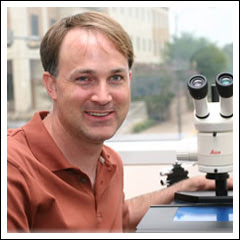 |
| Dr. Jon Pierce-Shimomura has a big bet on a tiny worm |
Sometimes Jerry and I feel a bit like Forrest Gump. You know, winding up at the right place at the right time in our lives against pretty unlikely odds. I’ll tell you why.
Last night Jerry and I attended an astonishing event, put on by the Rise School of Austin and the Down Syndrome Association of Central Texas.
Lots of other parents of kids with Down syndrome were there, too, to hear Professor Jon Pierce-Shimomura, Assistant Professor of Neurobiology at UT/Texas, fill us in on his current research and provide an overview of current research into Down syndrome.
Dr. Jerome Lejuene discovered the extra copy of chromosome #21 that characterizes typical Down syndrome in 1959. Finding the extra chromosome was huge, but even Dr. Lejeune did not hold out much hope for figuring out why and how it wreaks such developmental havoc, saying at the time “it would take less effort to find a cure for [Down syndrome] than to send a man to the moon.”
That's because, whereas conditions like cystic fibrosis may be caused by one gene, Down syndrome is caused by an entire chromosome packed with genes. Finding which one(s) cause the intellectual disability and physical characteristics of Down syndrome is not a simple task.
And not one many researchers bother with. As Dr. Pierce-Shimomura says, “If you were a researcher, would you rather investigate one gene, or 350?”
In the good professor's case, the answer to this question is easy. His name is Ocean Pierce-Shimomura, he's a bright busy ten-year-old, and he has Down syndrome.
And the Forrest Gump part? Well, in 1984, when our Kelly was five weeks old, I attended the 13th annual convention of the National Down Syndrome Congress in San Antonio. The speaker there was Jerome Lejuene. I had just gotten Kelly’s karyotype (which Dr. Lejuene developed) and it showed she had not one but two extra copies of the 21st chromosome. I was beside myself with worry.
But Dr. Lejuene calmed me down, saying he was certain she would not be doubly handicapped and would probably develop much as she would have with only one. And she has, having turned into a delightfully poised, well-mannered young woman of 27.
Then on the last day of the 2007 NDSC conference in Kansas City, Jerry and I attended the session of Dr. William Mobley, then of Stanford University, who presented exciting news and real hope for medical intervention in the disabling conditions that affect children and adults with Down syndrome.
Then next year Jerry and I went to Yosemite on vacation, and while riding bikes through the park he said, “I think we should go visit Bill Mobley. Let’s drive down to Palo Alto on Thursday.”
“O good Lord,” I said, “he’s an internationally recognized scientist. We can’t expect to just waltz onto the campus and find him and he’ll see us!”
(I should have known better, having been married to this guy for almost 40 years.)
So Thursday we find a parking place and the general area of campus where the lab was located. Who saunters by on that fine fall morning but Bill Mobley? A conversation ensued, a promise to come to Texas was extracted, information was exchanged, and we parted, my husband a satisfied man.
Several months later, Down Home Ranch, the Rise School, and DSACT presented an evening with William Mobley at the UT Ex-Student Center. We combined our mailing lists and invited everyone we could think of.
In the audience that evening was a brand-new assistant professor of bioscience, Dr. Jon Pierce-Shimomura. Someone introduced him to Dr. Mobley, who chose to present him to the audience as a researcher in the field of Down syndrome research.
Jon, actually having been brought to UT to undertake research on alcohol, didn’t know what to say, so he said nothing. One thing led to another, in part because of relationships created that night, and…who knows, post hypnotic suggestion, perhaps…as of today Jon directs the research of a$3M laboratory under a grant from the National Institutes of Health. His research swapping out genes in a tiny, simple worm (with whom we share a large preponderance of the same genetic material, humbling though that be) feeds into research on more complex creatures, suggesting which genes might prove better bets to test. (The worms go from infancy through middle age into senescence in 7 days.)
Even though funding for Down syndrome across the board is miserably low compared to many other conditions, real progress is being made. Let’s never forget: Ten years after Dr. Lejuene's comment, we did send a man to the moon.
There is real hope for our kids— for the older ones, that they’ll avoid the ravages of Alzheimer’s and retain their hard-won accomplishments as they age.
And for the little ones, well…them we’ll send to college.
Meanwhile, the clock is ticking. Go to the following link: ww.dsrtf.org/ to learn how to support Down syndrome research, and don’t think it won’t make a difference.
It will.